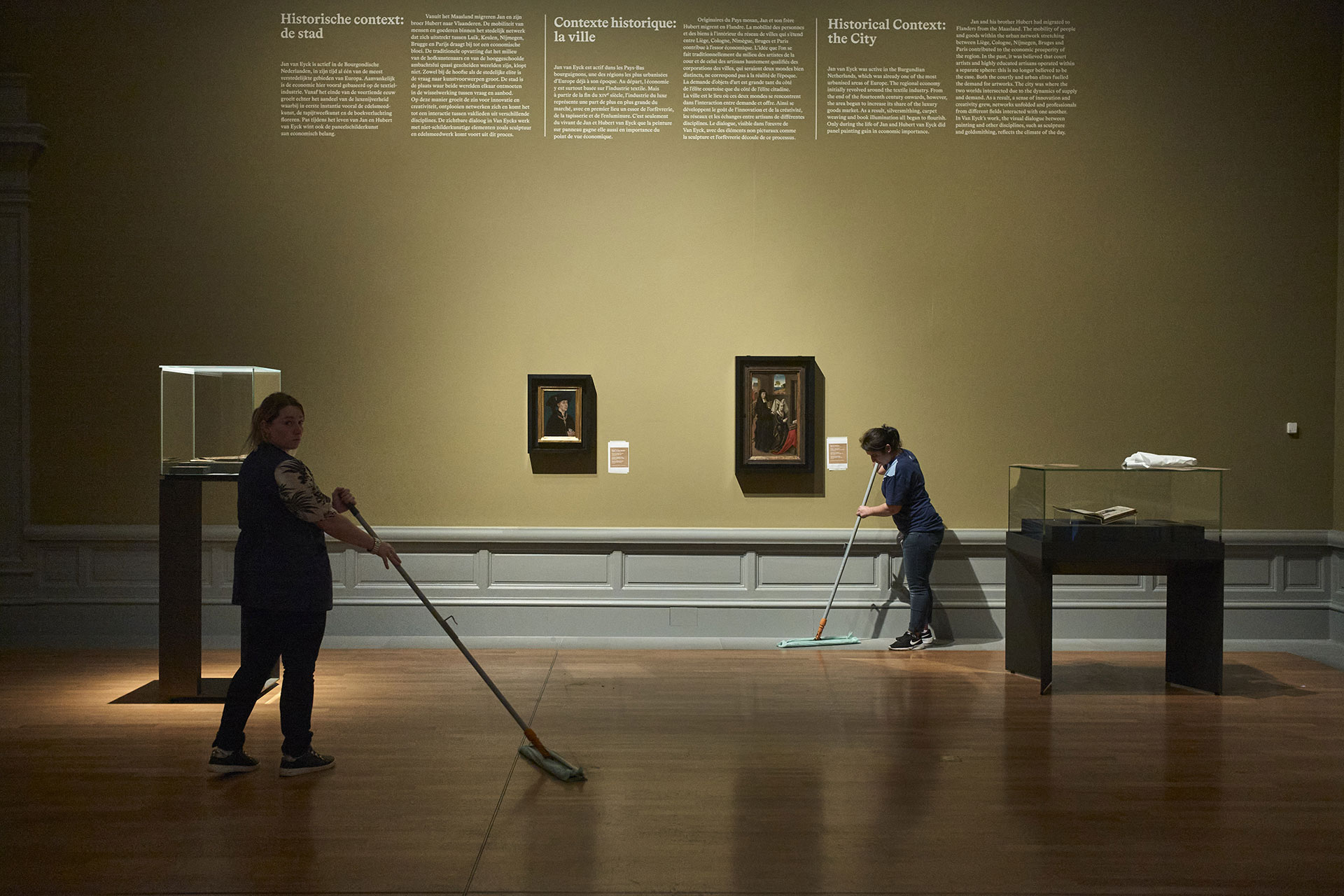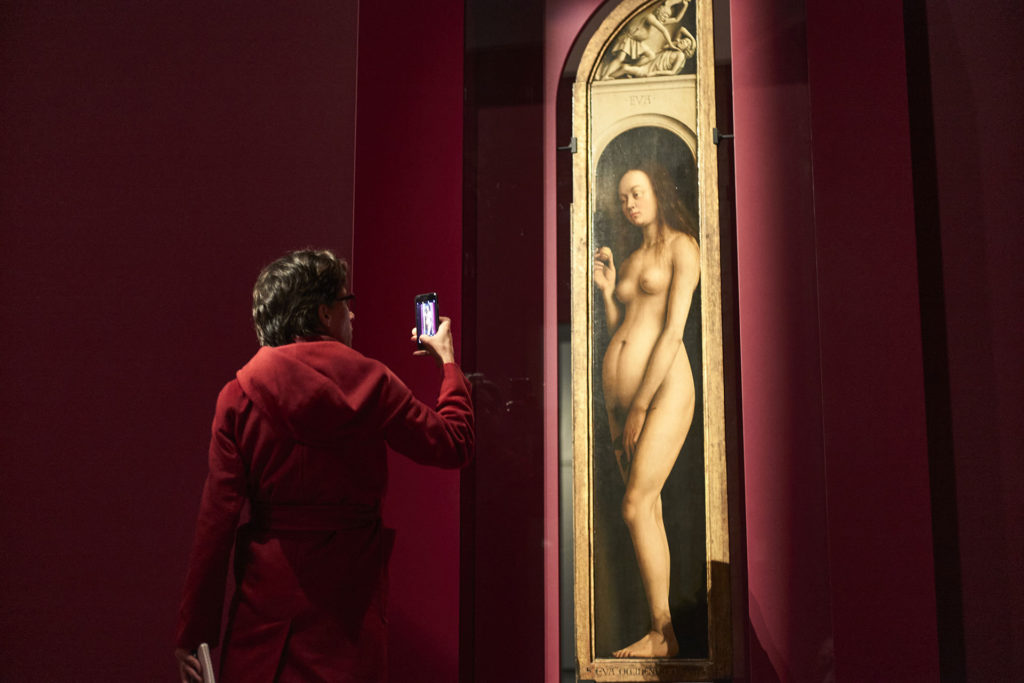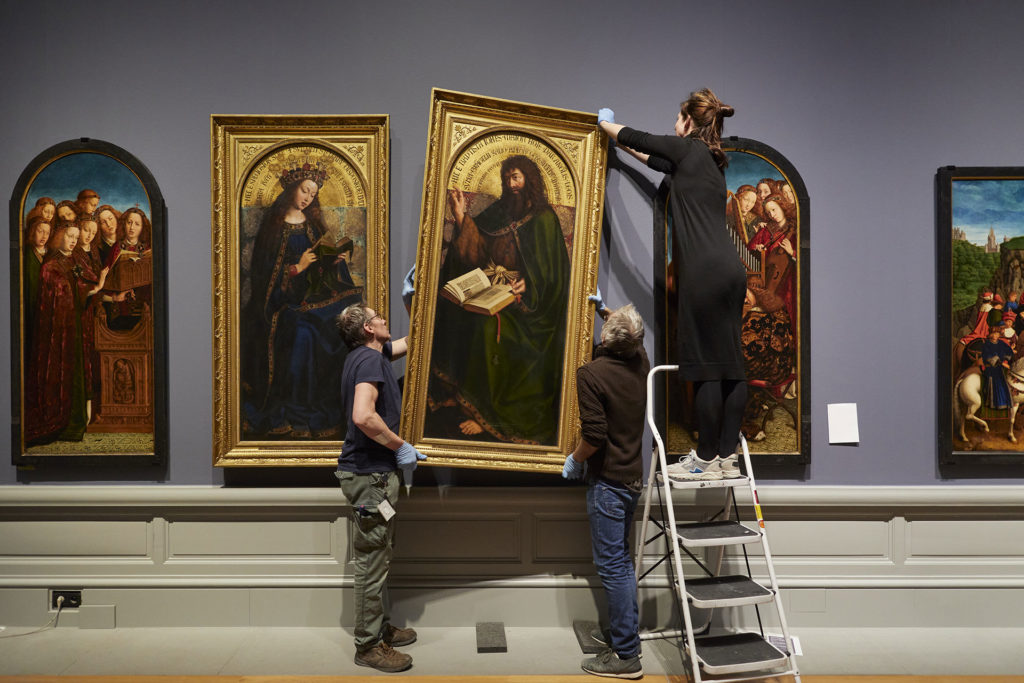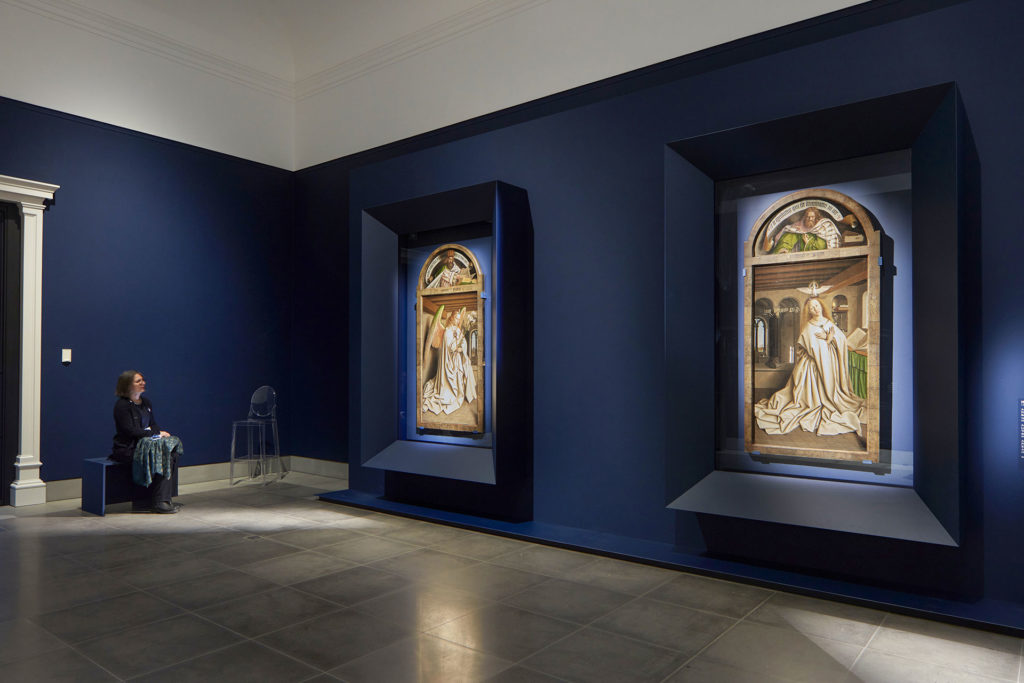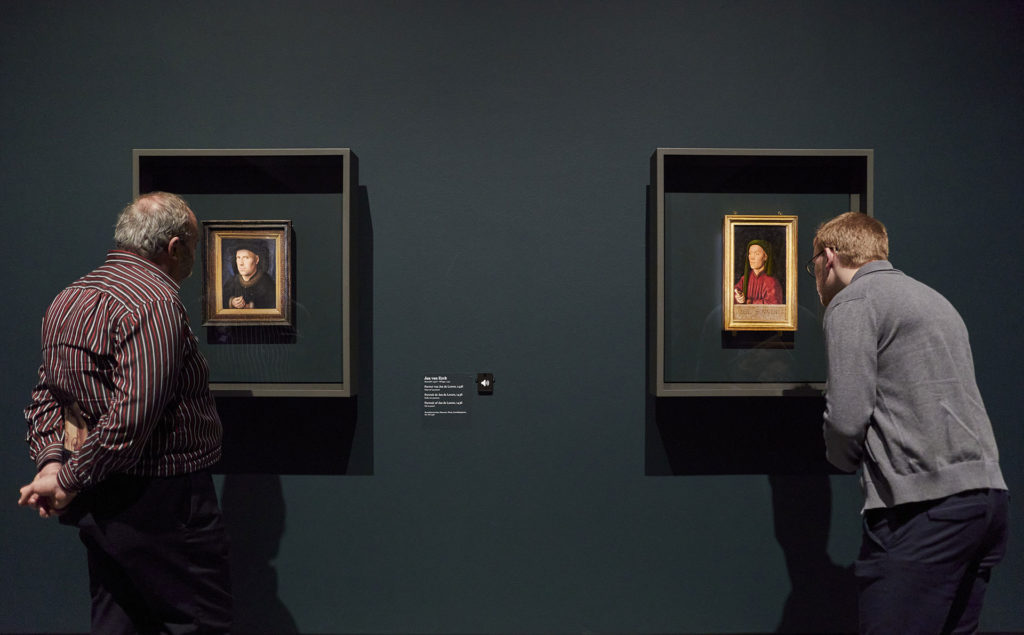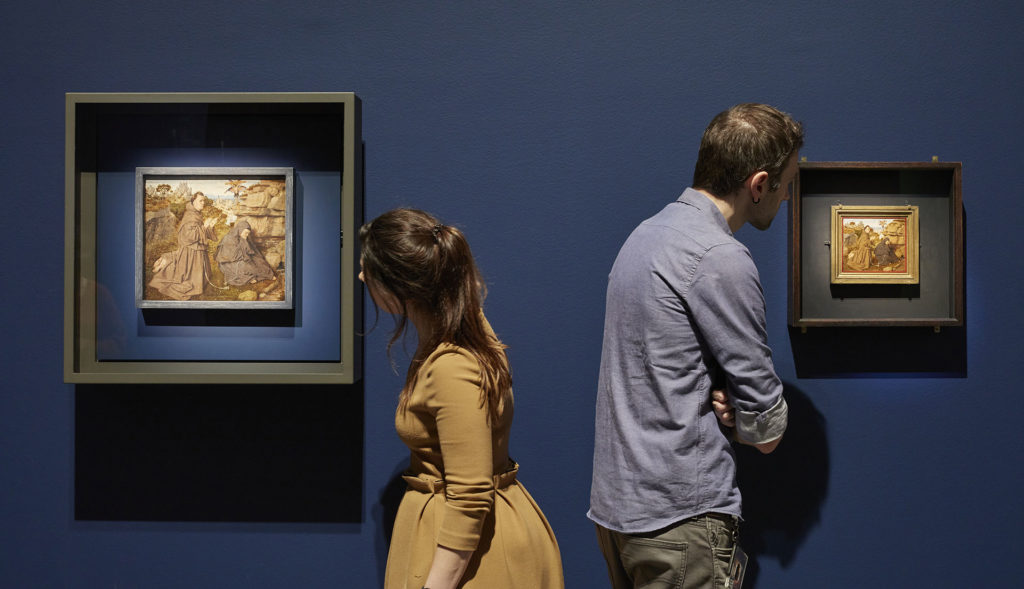Historical art exhibitions are like a machine in which the cogs intertwine and bring measurable effects. Announcements of new car models always feature information about the high-quality components, which arouses great emotions. Just as in the world of cars, in the world of art many await new proposals from top brands. 2020 marks the 500th anniversary of the death of the master of Renaissance painting Raphael Santi. This unique anniversary is celebrated at Rome’s Scuderie del Quirinale, where on 5 March the biggest exhibition of Raphael’s works in history was opened.
The exhibition is the result of years of work conducted by the researchers that continued to unravel new secrets of the “master of Urbino”. Art enthusiasts also interested in another “biggest exhibition in history” – the monographic exhibition of works by Jan van Eyck. Van Eyck. Een optische revolutie has been organized at the Museum of Fine Arts Ghent. It is a summary of conservation work of The Ghent Altarpiece that was carried out since 2012. Before the wings of this outstanding retable permanently return to St Bravo’s Cathedral, visitors will have a unique opportunity to take a close look at them. The exhibition is the Museum’s way of bidding farewell to the masterpiece. Through the exhibition, the institution can demonstrate to the public the effects of its long-term commitment to the conservation of this magnificent object.
Both exhibitions mentioned above were called the ‘must-see’ events of the spring season. However, they did not break any popularity records. The reason behind their commercial failure is the ongoing coronavirus pandemic. As a result of the restrictions imposed by the governments of Belgium and Italy, the museums remained closed to visitors for more than a month and a half. The exhibition held in Rome, for which about 60,000 tickets were sold online, closed on 8 March, just three days after its opening1.
Van Eyck. Een optische revolutie and Raffaello. 1520–1483 were both promoted as a “once-in-a-lifetime” experiences. However, they went down in history as exhibitions that viewers could only see for a month and a half through materials published online. A museum revolution is happening right before our eyes. Since mid-March, curatorial tours and video Q&As with experts are streamed online, while behind-the-scenes videos and high-resolution photographs are regularly published on museum websites and fan pages. I will use the example of the exhibition in Rome and in Ghent to analyze the methods that were used to make them available for the audience. I will also talk about the content of materials promoting both events.
Raffaello 1520–1483 is a grand exhibition held at Rome’s Scuderie del Quirinale. It is a result of cooperation with the Uffizi Gallery in Florence. The curatorial team was created by Marzia Faietti and Matteo Lafranconi, that also cooperated with Vincenzo Farinella and Francesco Paolo di Teodoro. The scale of the exhibition is clearly reflected by the number of institutions that agreed to rent their objects. These include the Italian National Gallery of Ancient Art, The National Archaeological Museum in Naples, The Vatican Museums, The Louvre, The National Gallery in London, The Prado Museum in Madrid, The National Gallery of Art in Washington, The Albertina, The British Museum, The Ashmolean, and The Museum of Fine Arts in Lille. One of the collectors that agreed to temporarily lend the most valuable objects was Queen Elizabeth II (The Royal Art Collection2. Among 204 exhibits featured in Raffaello 1520–1483, there as many as 120 paintings and drawings created by the master of Urbino himself3. There was no chance that the organizers could foresee at the stage of preparations that the exhibition would coincide with the coronavirus pandemic. Scuderie del Quirinale will probably have to return the borrowed objects on time – at this point it is difficult to predict whether the event will be extended. The exhibition is currently closed (as of May 4th) and its reopening scheduled for 17 May is still uncertain. Despite this fact, amateurs of Raphael’s paintings can view the works online on the YouTube channel of Scuderie del Quirinale, and the gallery’s Facebook fan page.
The gallery’s YouTube channel publishes video materials promoting the exhibition every few days4. Many of them the video comments by curators and experts in various fields, that talk about the life and work of Raphael, and about specific works presented at the Scuderie del Quirinale. One video features the biologist Giulia Caneva who speaks about plants in Raphael’s compositions. Another remarkable video documents the creation of a copy of Raphael’s tombstone that is located in the Roman Pantheon. The copy was created in 1:1 scale, with the use of modern techniques, including CNC machining. The director of Scuderie del Quirinale Matteo Lafranconi serves as “the face” of several videos. In a video published on 29 April, he talks with great professional expertise about The Portrait of Leo X and The Tempi Madonna. As he speaks, he reveals his own emotional attachment to Raphael’s works. The materials published on the YouTube channel of Scuderie del Quiridale are of very high quality. The reproductions of works can satisfy even the most demanding audience. The content of the videos has high educational value and provides information about the exhibition that reaches far beyond the traditional interests of art history. It is a shame that most of the videos are only available in Italian. Unfortunately, not all of them have English subtitles.
In the context of my further reflection, it is worth to mention the video form a virtual tour of the exhibition, which is the only one available in two language versions. On 26 March, a 13-minute video was published in Italian, followed by the English version published on 13 April. The narration of both videos presents the exhibition, and is a substitute for a quick guided tour. The videos contain careful shots and high resolution images. They present a series of exhibition rooms. Images are accompanied by the narrator’s commentary and calm background music. The narrator explains what the viewer can see at a given moment, and familiarizes the audience with the history of Raphael’s works, which the general aim of the exhibition.
The virtual tour through the exhibition reveals its concept and outlines the dramaturgy of the show. The exhibition begins with a recollection of 6 April 1520 – the day when Raphael passed away. As the title suggests, Raffaello 1520-1483 was staged with reversed chronology. It begins with the death of Raphael (this part of the exhibition features the copy of Raphael’s tombstone from the Pantheon I mentioned earlier) and ends with works representing the earliest period of his artistic activity. The exhibition closes with a self-portrait of Raphael from his juvenile years. The narrator briefly introduces the subsequent stages form the life of the “master of Urbino” and acts as a spokesman for artifacts. He skillfully shows how the story of Raphael is told through the works of art presented at the Scuderie del Quirinale. The guide is limited only to the background voice, which intensifies the message. As the viewer’s attention is focused only on objects, relationships between their groups become noticeable. The exhibition shows the deep impact that intiquity had a on the formation of Raphael’s style.
The Facebook fan page of the Scuderie del Quirinale also actively promotes the event. It contains links to the YouTube channel, as well as educational materials for the youngest members of the audience.
A series of posts were published on the fan page of the institution on 5 and 2 April. They were urging art scholars, students, and art lovers to submit questions about the exhibition and Raphael’s works in general. Questions were to be answered by the director of the museum. By doing so, Scuderie del Quirinale expressed its will to hold an open, scientific discussion inspired by the exhibition in spite of the closure.
Raffaello 1520-1483, managed to gathered a large audience. The online guided tour that I mentioned before has been viewed by about 62,0000 people ( as of 2 May). Surely, many of the viewers had not planned to see the exhibition at all. However, thanks to the Internet, all users have equal access to the event held at the Scuderie del Quirinale.
Van Eyck. Een optische revolutie had more luck than the exhibition of Raphael’s works. Many distinguished guests, including the Belgian royal couple, were present at its official opening that took place on 30 January. The exhibition was available for visitors until 1 February. It was supposed to run until the end of April, however, it was closed on 13 March due to the pandemic. On 20 April, an announcement was published on the website of the Museum of Fine Arts in Ghent. It informed that, despite the loosening of restrictions across Belgium, there are were plans of re-opening the exhibition for art enthusiasts5. As the organizers themselves admitted, while the exhibition was open, it could be viewed by as many as 900 visitors at a time6. As I was browsing the Internet in search for an estimate number of people that had the chance to see Van Eyck. Een optische revolutie, I came across a piece of information that mentioned 130 thousand visitors, a number not confirmed by any other sources.7
There has never been an exhibition of van Eyck’s works like this. Probably there will be no other like it in foreseeable future. Out of 22 preserved works by van Eyck with a confirmed attribution, as many as 13 are presented at the Ghent Museum of Fine Arts. The exhibition is complemented by paintings by artists who attended the workshop of the Grand Master, as well as his followers. The exhibition also features objects by van Eyck’s contemporaries, and well as by artists representing other historical periods but inspired by his compositions. They provide a broader context to Van Eyck’s works, emphasizing the innovative character of his artistic activity. The exhibition was organized in cooperation with 70 art institutions. According to the information published by Guide for Ghent, the exhibits were covered by insurance for a staggering amount of 850 thousand euros, which also proves the enormous scale of this whole undertaking.8 However, the thing that makes Van Eyck. Een optische revolutie really exceptional, is the very presence of the wings from The Ghent Altarpiece. After eight years of conservation work carried out at the museum, the masterpiece will return to the place of its previous exhibition, i.e. the Vijdt Chapel of the Saint Bravo Cathedral in Ghent. Once the exhibition is over, it will be very difficult to peacefully contemplate fragments of the altar. Within the Vijdt Chapel, The Ghent Altarpiece is displayed in a glass vitrine that bears semblance to a big aquarium. Watching this masterpiece under normal circumstances involves a steady walk around the glass that separates viewers from the altar, creating an almost one-metre-long safety buffer between the object and the audience. The proper reception of the altar somehow depends on the tourist traffic at a given moment. When the small chapel is crowded, it is difficult to see it – I experienced this personally during my visit to the Chapel on 17 May, 2019. The exhibition held at Ghent Museum of Fine Arts allows to peacefully contemplate panels of the pentaptych, including the two outermost panels with the figures of Adam and Eve. It was a perfect opportunity to take a close look at the panels and to study amazing details of each composition.
An online curatorial tour of the temporary exhibition of the Ghent museum premiered on the fan page Flemish Masters 2018–2020 on 8 April. It was guided by Till-Holger Borchert – an expert on van Eyck and Memling, and the co-curator of Van Eyck. Een optische revolutie.He accompanied the viewers during a 26-minute virtual tour of the exhibition. The video is characterized by technical precision. The camera follows Borchert as he makes stops in front of selected works, during which he explains to the audience what he can see. Borchet’s narration is illustrated with shots that focus exclusively on the objects he analyzes. Van Eyck’s paintings were filmed using slow camera shots. The quality of the close-ups is so satisfying that it allows to enjoy the beauty and technical mastery. It should be pointed out, however, that even the best digital photography is not able to replace contact with the authentic matter. As we watch the footage, it is not difficult to feel envy Borchert the possibility of individual contact with such remarkable works. The video also managed to capture the interiors of exposition rooms. The curator explains to the viewers how the exhibition was constructed and describes parts of it that he visits. The guide’s comments place the works in context. Together with the photographs, it creates a channel through witch viewers can explore the exhibition. Each parts of the exhibition are separated by music score, which gives the virtual tour a certain rhythm. Music can be heard when the curator finishes his story about the particular object and the camera shows the layout of the next exhibition room.
Till-Holger Borchert’s expertise is an unquestionable value of the video. His commentary is packed with an appropriate number of trivia, which makes the video absorbing. A trained eye of an art historian focuses on details that could be omitted by unseasoned viewers. By sharing his knowledge and his expertise, Borchert introduces the audience to the world of “secret knowledge”. Short curatorial stories focus on selected iconographic and iconological issues. The researcher mentions biographical elements – he refers to van Eyck’s personal history, but also presents people portrayed by the artist. He talks about the workshop secrets that distinguish works of the Master. He also reflects on the impact van Eyck’s works had on medieval audience. The online meeting with van Eyck and Borchert is a pleasant and informative experience.
The online curatorial tour of Van Eyck.Een optische revolutie draws attention to Van Eyck’s masterpieces collected at a temporary exhibition in the Ghent. The selection of paintings featured in the video is rather subjective, and limited to the highlights of the exhibition. In the video we can see some intriguing exhibits that are completely omitted by the guide. However, Borchett’s decision to present only selected works seems justified. The most valuable exhibits somehow dictate the nature of the exhibition. Other objects are subordinated to the “stars” of the exhibition and are reduced to the role of extras. But it all allows van Eyck’s genius to shine even brighter. Moreover, featuring more objects would significantly extended the video, which could have a negative effect and discourage some viewers. The fan page Flemish Masters 2018–2020 published more videos from the cycle The Stay At Home Museum. They were all made in the same style. The second episode is dedicated to Breugel, and the third to Rubens. All videos are available in English, which allows the wide public to explore the works of the masters of Flemish painting. After each of the online curatorial tours, the Flemish Masters 2018-2020 Facebook fan page holds a Q&A video chat with specialists. In the case of Van Eyck’s exhibition, Frederica Van Dam answered the questions live.
Enthusiasts of Van Eyck’s painting can fully satisfy their curiosity about the exhibition on its website9. In addition to the video of the curatorial tour I already mentioned, the website also features a link to the audio guide track of Van Eyck.Een optische revolutie. 27 interesting recordings provide extensive information about the exhibits, and explore their background (e.g. by presenting the rich culture of the Burgundian court during the reign of Philip the Good)10.
The creators of Raffaello 1520–1483 and Van Eyck. Een optische revolutie used two different approaches to present their online tours. The video published by the Scuderie del Quirinale focuses on the narrative of the exhibition and develops its “content”. It is a story consisting of chapters determined by successive stages of the painter’s life. Inspiration with ancient art, that is considered an important component of Raphael’s style, is particularly highlighted. The video brings a synthetic look at the whole exhibition. The online tour of the exhibition the limits the presence of the guide only to his voice. It allows the viewer to focus on reproductions of Raphael’s works that illustrate the narrator’s story. The tour of Van Eyck. Een optische revolutie is more focused on objects, which is due to the character of this event. The exhibition is constructed around one particular masterpiece– The Ghent Altarpiece. It is therefore not surprising that the boards of the altarpiece have a special place in the video. It is worth noting that the co-curator, Till-Holger Borchert, serves as the guide of the online tour. The tour is Borchert’s pure display of erudition caught by a camera. The viewers can see the high-resolution reproductions of the works, Borchert’s can see from a close distance. It creates an impression of looking at the works through the eyes of an expert. Viewers overcome the barrier of distance by witnessing an authentic art historian excited about the possibility of experiencing the works of van Eyck. For Borchert, the artist’s genius is something unquestionable. However, it needs to be stressed that Borchert only comments on works selected by himself – the highlights of the exhibition. Borchert does not reveal any new information about the artist. The guide does not mention the excellent works that serve as a background for The Ghent Altarpiece and paintings borrowed from renowned European and American institutions.
The two great exhibitions (exhibition-machines) are the result of the work of specialists representing many fields. They prove that not only art historians are interested in art. The interdisciplinary studies on the legacy of van Eyck and Raphael materialized in the form of exhibitions that, to their misfortune. coincided with the coronavirus pandemic. The Museum of Fine Arts in Ghent and the Scuderie del Quirinale faced the enormous challenge of making temporary “once-in-a-lifetime” exhibitions available for the audience online. It turned out beneficial for those who had intended to travel to Italy or Belgium to see the exhibitions, and for art enthusiast who could previously only dream about seeing such masterpieces. The Internet has granted everyone equal access to the events. The digital materials published by the institutions are of educational value and include different audiences. The videos published on the YouTube channel of the Scuderie del Quirinale are examples of a well-planned programme aimed at popularizing science, rather than on promoting the institution and attracting visitors.
The Scuderie del Quirinale and the Museum of Fine Arts in Ghent have proved that it is possible to make exhibitions accessible for the audience despite the difficult time culture is facing. Both institutions made a good use of their human, technological, and financial resources. The most important materials through which the viewers could get acquainted with the exhibitions were video guided tours available online. In both cases the videos are characterized by high quality shots and professional commentary. It proves that the choice of a guide is of great importance for the overall message of a virtual tour. The impersonal reader and narrator has advantages and disadvantages. The video editing turned out to be extremely important, while the score set the pace for the virtual tours.
In my opinion, the achievements of the two institutions mentioned in this article should be widely appreciated. They continue to publish high quality materials. Adapting the strategies they have tested means learning from the best. The vaccine that could save exhibitions during the coronavirus pandemic was developed in Ghent and in Rome. It can also be successfully applied by other museums and art galleries. It is possible that its “antibodies” will permanently modernize the museum industry, and it will become a standard to provide online guided tours of the exhibition. It remains to be seen if this treatment will be widely accepted by art institutions.
- https://news.artnet.com/exhibitions/see-raphael-blockbuste-shuttered-italy-lockdown-1798848 [dostęp: 20.04.2020]. [↩]
- https://www.scuderiequirinale.it/mostra/copia-di-raffaello [dostęp 4.05.2020]. [↩]
- https://www.uffizi.it/en/events/raphael-rome [dostęp 4.05.2020]. [↩]
- https://www.youtube.com/channel/UCw9HQLDh6-rm_xtk8HMmOwA [dostęp 4.05.2020]. [↩]
- https://www.mskgent.be/en/news/van-eyck-exhibition-closed [dostęp 20.04.2020]. [↩]
- Tamże. [↩]
- https://aawsat.com/english/home/article/2246391/flanders-celebrates-year-jan-van-eyck-virtually [dostęp: 20.04.2020]. [↩]
- https://www.guide-for-ghent.com/blog/van-eyck-exhibition [dostęp 20.04.2020]. [↩]
- https://vaneyck2020.be/ [dostęp: 4.05.2020]. [↩]
- https://www.mapmyvisit.com/viewtour/3632/en/F81934B55CD19D33E8B5AE90A5F77A5C [dostęp: 4.05.2020]. [↩]
